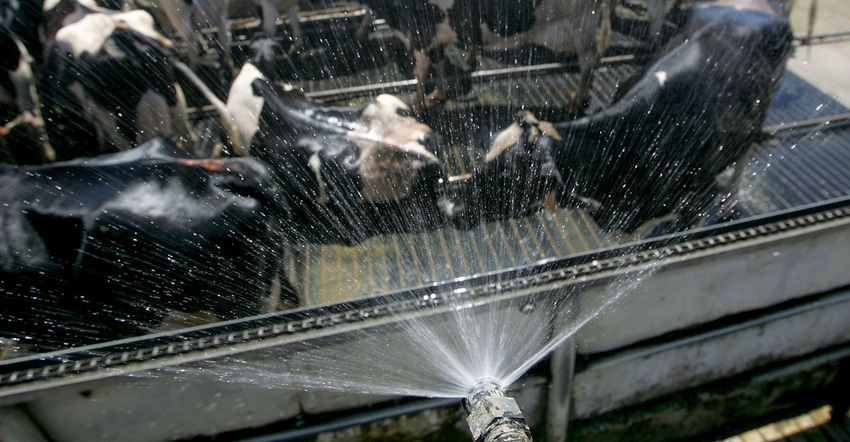May 10, 2019

It might be a little early in the growing season, but it’s never too early to get the barn ready for summer, especially on dairy farms.
Heat stress occurs when a cow’s heat gain is greater than her ability to lose it. The goal is to balance heat gain and loss over a 24-hour period.
Productive dairy cows may experience heat stress when the temperature humidity index is 68 or greater.
Farmers can reduce heat stress in many ways, from the most basic method of just providing more shade to installing large, sophisticated air-cooling systems.
Here are five things you can to reduce heat stress in the barn this summer:
1. Provide shade. Protecting cows from direct solar radiation helps lower their body temperature and respiration rate.
Shade can be provided by trees, buildings or shade structures. Roofs and shade structures should be at least 12-feet high and oriented properly.
Buildings and covered outside feeding areas are typically placed east-west to minimize sunlight during the day. Placing pasture or dry-lot shade structures north-south allows shade to move from west to east, helping to keep the resting area dry.
2. Have good air exchange. An air exchange every minute or less during summer is essential to remove moisture, gases, heat and other pollutants from the barn.
Without proper air exchange, other heat-stress abatement techniques will not work effectively.
Mechanically ventilated dairy buildings use exhaust fans, and properly sized and placed inlets throughout the space. Tunnel ventilation can provide a rapid air exchange — typically less than 45 seconds — in tie-stall barns.
Naturally ventilated buildings depend primarily on wind speed and direction to drive the air exchange. Buildings with side and end walls fully open to resting cows creates a “pavilion-like” design during summer.
When the warm weather exchange rate in naturally ventilated buildings is challenged by topography or building limitations, well-designed tunnel or cross-ventilation systems can provide the necessary air exchange.
3. Use circulation fans. Turbulent air movement around cows increases convective heat transfer, enhancing evaporation and minimizing hot spots.
Air speeds of 3.5 to 5 miles per hour are preferred in resting, feeding and holding areas.
Thirty-six to 52-inch diameter axial circulation fans can provide excellent air movement. To be effective, the fans must be placed, in line, no more than 10 times their diameter apart. For side-by-side applications, place fans two to three times their diameter apart.
High-volume, low-speed fans can also provide air movement at cow level, but they must be placed over the animals and no more than twice their diameter apart.
4. Have plenty of watering stations. Increased respiration and urination during hot weather may increase drinking water intake by 20% or more. Watering stations need to be conveniently located to allow multiple cows access and to keep up with water demand.
5. Invest in a cooling system. Evaporative cooling uses water to increase heat transfer from cows.
Direct evaporative cooling (DEC) systems intermittently apply and evaporate water from the cow’s skin, drawing heat directly from the body. Indirect evaporative cooling (IEC) lowers the air temperature around the cow, increasing her heat transfer rate.
Spray cooling systems are low-pressure DEC systems installed in feeding and holding areas that use a 5- to 15-minute wet-dry cycle. Spray nozzles emit a coarse droplet that penetrates the cow’s hair coat, soaking her skin for one to three minutes. Fans provide air movement for the remainder of the cycle to speed evaporation and draw heat away from the body.
Studies show that the respiration rate of a heat-stressed cow decreases with the first wet-dry cycle. DEC systems are the most effective cooling method for cows in more humid climates, but they require a significant water supply and good drainage.
IEC systems use heat in the air to evaporate water, lowering the dry bulb air temperature. The heat transfer rate increases when the difference in temperature between the cow’s body and surrounding air is greater. Heat transfer from within the body also improves as the cows inhale cooler air.
Fogging and misting are examples of IEC systems that use pressure to force water through nozzles, emitting very small droplets. High-pressure systems emit finer droplets that have a better chance of evaporating before settling on the cow’s hair coat, resting surface and floor. Nozzles for lower-pressure systems emit larger droplets and are typically installed on circulation fans so air movement can aid in evaporation.
Pressurized IEC systems are popular in arid climates where the droplets are more likely to evaporate suspended in the air. These systems are prone to “drift” in naturally ventilated buildings.
Evaporative pads are another IEC system. They comprise thick, water-soaked corrugated pads that are installed at inlet openings used with tunnel and cross ventilation systems.
Outside air drawn through the pad evaporates, lowering the dry bulb temperature. All air drawn through the inlet is cooled and can only pick up as much moisture as conditions allow.
Since evaporative cooling systems add water to the animal air space, ventilation systems that provide a good air exchange to remove moisture-laden air and circulation fans to enhance evaporation are essential.
Source: Penn State University, which is solely responsible for the information provided and is wholly owned by the source. Informa Business Media and all its subsidiaries are not responsible for any of the content contained in this information asset.
You May Also Like




